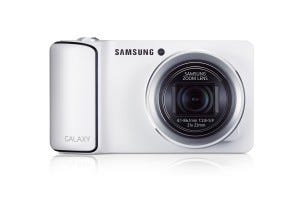Samsung refreshes the connected camera business model
Digital cameras seemed like an obvious, early choice for the embedding of wireless connectivity. But the realisation of this has by and large been foiled – mainly due to the business model for cameras being based on content creation rather than content consumption.
September 12, 2012

By Jamie Moss
Digital cameras seemed like an obvious, early choice for the embedding of wireless connectivity. But the realisation of this has by and large been foiled – mainly due to the business model for cameras being based on content creation rather than content consumption.
Consumption versus creation
With something like a Kindle or (in the future) a PSP Vita with embedded cellular (rather than the user-installed Mobile Broadband SIM that it has today), payment for data transport occurs on an ad-hoc basis – as and when someone buys a new book or game. The consumer is getting something new that they would have had to pay for anyway, and it just so happens that a portion of the cost goes towards the use of the cellular network to deliver it.
Conversely a camera is a be-all and end-all device. It is not a means to a greater end and has not traditionally been used as a vehicle for driving content consumption – or indeed to enable any other business model beyond the simple sale of the hardware itself. Connectivity in cameras has in essence just been a differentiator to sell more units.
But this is not the reason why Kindles and PSP Vitas contain cellular modems. For those devices it’s more about driving the sale of books and games. Just as today’s desktop printer manufacturers make their revenue from the recurrent sale of consumables like ink cartridges, rather than from the one-off sale of the hardware itself.
To wifi or not wifi
It is hard for camera manufacturers to justify to consumers why they should have to pay anything extra to transport their own user-generated content from one device to another. They might as well use a free alternative such as wifi, or a data cable, or by hot-swapping an SD card – especially when digital cameras encourage people to take so many more photos than they used to do with film cameras.
It is for this reason that wifi has been the only real wireless technology to make it into cameras – and even then only into a few. At CES in 2011 only one of the many digital cameras on display from the numerous manufacturers there had any embedded connectivity. Many of the vendors reasoned that if wifi is the most practical solution, then why go to the expense of embedding it at all when the user can just buy an eye-Fi wifi-enabled SD card?
Samsung has been the most active proponent of embedding connectivity and now has a whole range of wifi enabled cameras. It was also the first manufacturer to use wifi to link a digital camera to an Android phone. To thereby allow that phone to be used as a remote control, as a viewer for the pictures taken and as a tethered modem to upload them to the cloud.
Unique connectivity
In light of this, the act of joining a Galaxy S-series phone and a digital camera to create the Samsung Galaxy Camera was probably the next logical step for the manufacturer. However, one could claim that Nokia has already done just that with the 808 PureView, albeit by making a phone into a powerful camera, rather than by turning a camera into a phone!

The Samsung Galaxy Camera
Samsung isn’t the first to put an Android operating system into a camera either, Nikon did that a few weeks earlier with the Coolpix S800c. However industry observers have been quick to pick up on the fact that Nikon used Android 2.3 (Gingerbread), while Samsung has used the very latest Android 4.1 (Jelly Bean). But what is revolutionary about the Samsung Galaxy Camera is that is has been announced as featuring 3G+wifi and 4G+wifi connectivity combinations.
In a ground-breaking move the camera contains its own cellular modem and does not simply tether itself to a mobile phone for its wide-area connectivity. It will be interesting to see how Samsung bundles the service of the cellular connectivity. It appears that a user-installable mobile broadband SIM will be used, rather than an embedded SIM. But will the end user be left to choose their own wireless carrier, or will there be a preferred service provider as with Sony’s PSP Vita?
You May Also Like








.png?width=300&auto=webp&quality=80&disable=upscale)


_1.jpg?width=300&auto=webp&quality=80&disable=upscale)